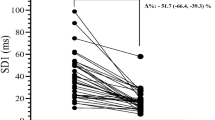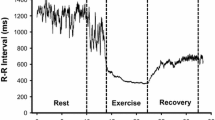Abstract
Objectives
Identify the underlying role of resting heart rate variability (HRV) in the hearts response to graded exercise testing (GXT).
Methods
Resting 5-min HRV and heart rate (HR) measurements were made in 33 volunteers (19 males, median age 34, range 25–63 years and 14 females median age 48, range 21–63 years). Measures of \( \dot{V}{\text{O}}_{{ 2 {\text{peak}}}} \) and HR obtained during a maximal GXT and heart rate recovery (HRR) post-GXT were assessed for associations with resting HRV. Differences and effect size (d) for measures of HRV were assessed between groups based on established risk cut-points for resting, exercise and recovery HR responses.
Results
Small associations were observed for the majority of resting HRV and GXT HR responses (best r value = −0.27, P > 0.05). Measures of HRV demonstrated moderate associations with HRR (best r value = 0.46, P < 0.05) and were able to predict a negative risk HRR. In contrast to other dependent variables, measures of HRV were consistently able to demonstrate significant and moderate to large (d = 0.9–2.0) differences between groups based on literature defined prognostic HR cut-points.
Interpretation
Small associations with HR responses to exercise prevent their accurate prediction from resting HRV. Data support the use of vagally mediated resting HRV in predicting better HRR. Lower resting autonomic modulations underlined high risk resting and exercise HR responses. Resting short-term HRV measurements should be considered when assessing cardiac autonomic health from the HR response before, during and/or after exercise.
Similar content being viewed by others
References
ACSM (2000) ACSM’s guidelines for exercise testing and prescription. Lippincott Williams and Wilkins, Philadelphia
Bigger JT, Fleiss JL, Rolnitzky LM, Steinman RC (1993) The ability of several short-term measures of RR variability to predict mortality after myocardial infarction. Circulation 88:927–934
Cohen J (1988) Statistical power analysis for the behavioural sciences. Lawrene Earlbaum Associates, Hillsdale
Cole CR, Blackstone EH, Pashkow FJ, Snader CE, Lauer MS (1999) Heart rate recovery immediately after exercise as a predictor of mortality. New Engl J Med 341:1351–1357
Coumel P, Maison-Blance P, Catuli D (1994) Heart rate and heart rate variability in normal young adults. J Cardiovasc Electr 5:899–911
Dewey FE, Freeman JV, Engel G et al (2007) Novel predictor of prognosis from exercise stress testing: heart rate variability response to the exercise treadmill test. Am Heart J 153:281–288
Evrengul H, Tanriverdi H, Kose S et al (2006) The relationship between heart rate recovery and heart rate variability in coronary artery disease. Ann Noninvasive Electrocardiol 11:154–162
Fagraeus L, Linnarsson D (1976) Autonomic origin of heart rate fluctuations at the onset of muscular exercise. J Appl Physiol 40:679–682
Falcone C, Buzzi MP, Klersy C, Schwartz PJ (2005) Rapid heart rate increase at the onset of exercise predicts adverse cardiac events in patients with coronary artery disease. Circulation 112:1959–1964
Gardner MJ, Altman DG (2000) Confidence intervals rather than P values. In: Altman DG, Machin D, Bryant TN, Gardner MJ (eds) Statistics with confidence: confidence intervals and statistical guidelines, 2nd edn. British Medical Journal Books, London, pp 15–27
Gersh W (1991) Smoothness priors. In: Brillinger D, Caines P, Geweke J, Parzen E, Rosenblatt M, Taqqu MS (eds) New directions in time series analysis, part II. Springer, Berlin, pp 113–146
Hopkins WG (2000) A new view of statistics. Internet Society for Sport Science: http://www.sportsci.org/resoure/stats/
Jouven X, Empana JP, Schwartz PJ, Desnos M, Courbon D, Ducimetiere P (2005) Heart-rate profile during exercise as a predictor of sudden death. New Engl J Med 352:1951–1958
Kannankeril PJ, Le FK, Kadish AH, Goldberger JJ (2004) Parasympathetic effects on heart rate recovery after exercise. J Invest Med 52:394–401
La Rovere MT, Bigger JT Jr, Marcus FI, Mortara A, Schwartz PJ (1998) Baroreflex sensitivity and heart-rate variability in prediction of total cardiac mortality after myocardial infarction. ATRAMI (Autonomic Tone and Reflexes After Myocardial Infarction) Investigators. Lancet 351(9101):478–484
Lauer MS, Okin PM, Larson MG, Evans JC, Levy D (1996) Impaired heart rate response to graded exercise. Circulation 93:1520–1526
Leeper NJ, Dewey FE, Ashley EA et al (2007) Prognostic value of heart rate increase at onset of exercise testing. Circulation 115:468–474
Malik M, Camm AJ (1993) Components of heart rate variability: what they really mean and what we really measure. Am J Cardiol 74:417
Navare SM, Thompson PD (2003) Acute cardiovascular response to exercise and it implications for exercise testing. J Nucl Cardiol 10:521–528
Niskanen JP, Tarvainen MP, Ranta-aho PO, Karjalainen PA (2004) Software for advanced HRV analysis. Comput Meth Prog Bio 76:73–81
Nolan J, Batin PD, Andrews R et al (1998) Prospective study of heart rate variability and mortality in chronic heart failure: results of the United Kingdom heart failure evaluation and assessment of risk trial (UK-heart). Circulation 98:1510–1516
Rennie KL, Hemingway H, Kumari M, Brunner E, Malik M, Marmot M (2003) Effects of moderate and vigorous physical activity on heart rate variability in a British study of civil servants. Am J Epidemiol 158:135–143
Robinson BF, Epstein SE, Beiser D, Braunwald E (1966) Control of heart rate by the autonomic nervous system: studies in man on the interrelation between baroreceptor mechanisms and exercise. Circ Res 19:400–411
Ruha A, Sallinen S, Nissila S (1997) A real-time microprocessor QRS detector system with a 1-ms timing accuracy for the measurement of ambulatory HRV. IEEE Trans Biomed Eng 44:159–167
Savin WM, Davidson DM, Haskell WL (1982) Autonomic contribution to heart rate recovery from exercise in humans. J Appl Physiol 53:1572–1575
Task Force (1996) Heart rate variability: standards of measurement, physiological interpretation and clinical use. Task Force of the European Society of Cardiology and the North American Society of Pacing and Electrophysiology. Circulation 93:1043–1065
Tsuji H, Larson MG, Venditti FJ Jr et al (1996) Impact of reduced heart rate variability on risk for cardiac events. The Framingham Heart Study. Circulation 94:2850–2855
Tsuji H, Venditti FJ Jr, Manders ES et al (1994) Reduced heart rate variability and mortality risk in an elderly cohort. The Framingham Heart Study. Circulation 90:878–883
Van Hoogenhuyze D, Weinstein N, Martin G et al (1991) Reproducibility and relation to mean heart rate of heart rate variability in normal subjects and in patients with congestive heart failure secondary to coronary artery disease. Am J Cardiol 68:1668–1676
Author information
Authors and Affiliations
Corresponding author
Rights and permissions
About this article
Cite this article
Nunan, D., Jakovljevic, D.G., Donovan, G. et al. Resting autonomic modulations and the heart rate response to exercise. Clin Auton Res 20, 213–221 (2010). https://doi.org/10.1007/s10286-010-0073-7
Received:
Accepted:
Published:
Issue Date:
DOI: https://doi.org/10.1007/s10286-010-0073-7




